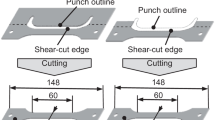Abstract
Manufacturing of sheet metal components feeds into several domains such as automotive, aerospace and strategic applications. The optimum process and tool design are crucial in ensuring successful manufacturing of components without developing any defects. The current trend is to do it right the first time during the industrial stamping practice, so that the costly shop floor trials are eliminated or at least minimized. One of the common failures that are observed during manufacturing of industrial sheet metal components is the splitting/cracking. The present work focuses on addressing the design considerations for preventing development of such defects. Traditionally, the strain-based forming limit diagram (FLD) is used to assess if a proposed process and tool design will lead to splitting failures. The approach is to measure or predict the strains that will develop during the stamping process and to infer that splitting failures will occur if these strains are above the FLD. The optimum process and tool design should ensure that the strains developed in the component must be below the FLD. The approach of using the strain-based FLD has serious limitation, as it does not account for the influence of complex strain paths on the forming limit strains. As an alternative, stress-based FLDs have been proposed, which does address the effect of complex strain paths. But, the stress-based FLDs are not intuitive and therefore are not very suitable to use for analysis of industrial sheet metal components. In this work, a novel approach, based on monitoring development of local thickness gradients during manufacturing of sheet metal components, is proposed to assess a given process and tool design for developing splitting/cracking failures. The novel approach is validated for sheets of different metals and thicknesses. The effect of bilinear strains paths on the forming limits is captured and validated using this proposed novel approach. A new approach, based on the novel thickness gradient criteria, is proposed for quantifying the forming severity of industrial sheet metal components.








Similar content being viewed by others
References
Keeler S P, and Backofen W A, Trans ASM 56 (1963) 25.
Goodwin G M, SAE paper No. 680093 (1968) p 380.
Keeler S P, Advances in Deformation Processing, Springer, Boston (1978) p 127.
ISO 12004-2:2008, Metallic Materials—Sheet and Strip—Determination of Forming-Limit Curves—Part 2: Determination of Forming-Limit Curves in the Laboratory (2008).
Martínez-Donaire A J, García-Lomas F J, and Vallellano C, Mater Des 57 (2014) 135.
Merklein M, Kuppert A, and Geiger M, CIRP Ann Manuf Technol 59 (2010) 295.
Hotz W, Merklein M, Kuppert A, Friebe H, and Klein M, Key Eng Mater 549 (2013) 397.
Silva M B, Martínez-Donaire A J, Centeno G, Morales-Palma D, Vallellano C, and Martinsa P A F, Proc Eng 132 (2015) 342.
Kuwabara T, Ikeda S, and Kuroda K, J Mater Process Technol 80–81 (1998) 517.
International Standard ISO16842: Metallic materials—sheet and strip—biaxial tensile testing method using a cruciform test-piece, Technical report (2014).
Marciniak Z, and Kuczynski K, Int J Mech Sci 9 (1967) 609.
Muschenborn W and Sonne H M, Arch Eissenhüttenwes 46 (1975) 597.
Laukonis J V and Ghosh A K, Met Trans 9A (1978) 1849.
Ranta-Escola A J, Mater Technol 7 (1980) 45.
Graf A and Hosford W F, Met Trans 24A (1993) 2503.
Graf A and Hosford W F, Int J Mech Sci 36 (1994) 897.
Stoughton T B, Int J Mech Sci 42 (1999) 1.
Stoughton T B, J Eng Mater Technol 123 (2001) 417.
Sujit K, Date P P and Narasimhan K, J Mater Process Technol 45 (1994) 583.
Nandedkar V, Formability Studies on a Deep Drawing Quality Steel, Ph D Thesis, IIT Bombay, India (2000).
Ganguly S, Assessment and Validation of Thickness Gradient Criterion for Measurement and Analysis of Strain Localization in Sheet Metal Forming, Ph D Thesis, IIT Bombay, India (2016).
Ganguly S, and Narasimhan K, in Conference Proceedings IDDRG, Linz (2016).
Kakathkar V, Bhargava M, Narasimhan K, and Mishra S K, in Conference Proceedings IDDRG, China (2015).
Omar A, Narasimhan K, and Tewari A, in Conference Proceedings ICEMP Bhubaneswar, India (2014).
Björklund O, and Nilsson L, J Mater Process Technol 214 (2014) 1190.
Acknowledgements
The authors thank R&D at Tata Steel Limited as well as Metallurgical Engineering and Materials Science Department and Mechanical Engineering Department at IIT Bombay for providing the required facilities for carrying out the present work. The authors also acknowledge the contribution of Mr. Rudra Bubai Sarkar, Tata Steel Limited, who provided us with the experimental FLD data from one of his earlier works.
Author information
Authors and Affiliations
Corresponding author
Additional information
Publisher's Note
Springer Nature remains neutral with regard to jurisdictional claims in published maps and institutional affiliations.
Rights and permissions
About this article
Cite this article
Ganguly, S., Raj, A. & Narasimhan, K. A Novel Approach for Process and Tool Design During Manufacturing of Industrial Sheet Metal Components. Trans Indian Inst Met 74, 1203–1212 (2021). https://doi.org/10.1007/s12666-020-02145-x
Received:
Accepted:
Published:
Issue Date:
DOI: https://doi.org/10.1007/s12666-020-02145-x




